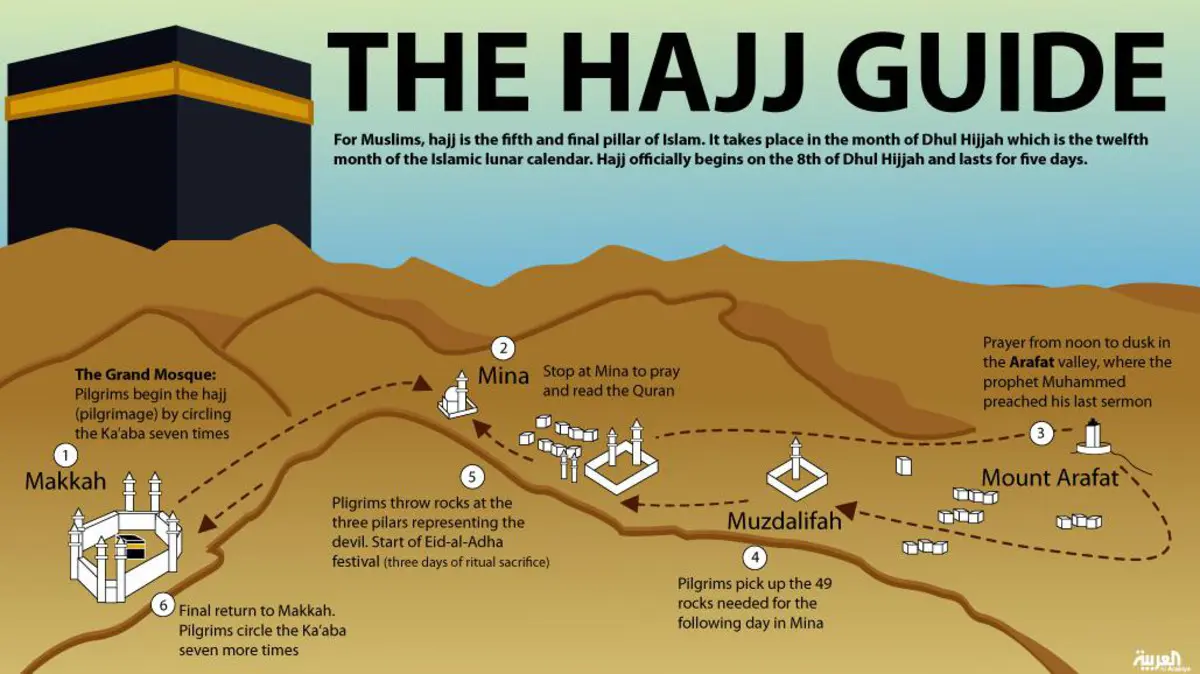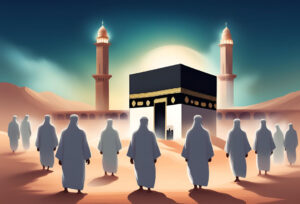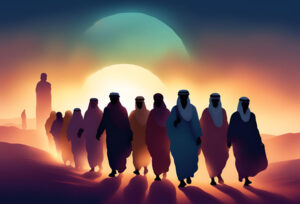 In this article of Hajj all you need to know about the Islamic Pilgrimage we tried to cover all the aspects.
Hajj 1445 Hijri is around the corner, with thousands of pilgrims making their way to the Holy city of Makkah. There is hardly any gathering as big as the Hajj across the globe, and this is a practice that has been ongoing for centuries. It is a significant event where hundreds of thousands gather for a shared purpose, breaking any barriers of geographical, racial or cultural divides. It is crucial to understand the different facets of this grand event in order to grasp its significance.
History of Hajj:
While the formal shape of Hajj, with all its instructions and itineraries were finalized by Muhammad (PBUH) during his only pilgrimage in 628 A.D, the origins of the act of worship date over 4,000 years to the time of Ibrahim. It is said that Hajj connects Muslims to their father Ibrahim – the prophet to whom all the Semitic religions (Islam, Christianity and Judaism) are associated.
The Kaaba was raised by Ibrahim and his son Ismael. Tawaaf – circling the Kaaba seven times - constitutes one of the three obligations of the Hajj, and pays a tribute to Ibrahim. However, this is not the only connection between Hajj and Ibrahim’s family and their sacrifices. Muslims are also ordained to make seven rounds between the mountains of Safa and Marwa as a tribute to Hajar’s (Ibrahim’s wife) frantic running between the two in search of water for her son, Ismael.
On the 10th of Dhul Hajjah – the day of Eid-ul-Adha - Muslims worldwife offer a sacrifice of an animal to commemorate the trial of Ibrahim where he was ordered to sacrifice his son, Ismael, but was replaced with a sheep.
Interestingly, even before the advent of Islam, Hajj was practiced by the Arabian tribes, who would travel to Makkah during the Holy month. Although the Quraish and other Arabian tribes were not followers of Ibrahim’s monotheistic religion, they were Bani Ismael (descendants of Ismael), and held high regard for Ibrahim.
After the conquest of Makkah by Muhammad (PBUH), the Islamic – and original Ibrahimic - way of Hajj was enforced and the rulings were set out. From 628 A.D, all rulers have continued to take actions to make the Holy Pilgrimage accessible for Muslims around the world.
Rituals of Hajj:
In this article of Hajj all you need to know about the Islamic Pilgrimage we tried to cover all the aspects.
Hajj 1445 Hijri is around the corner, with thousands of pilgrims making their way to the Holy city of Makkah. There is hardly any gathering as big as the Hajj across the globe, and this is a practice that has been ongoing for centuries. It is a significant event where hundreds of thousands gather for a shared purpose, breaking any barriers of geographical, racial or cultural divides. It is crucial to understand the different facets of this grand event in order to grasp its significance.
History of Hajj:
While the formal shape of Hajj, with all its instructions and itineraries were finalized by Muhammad (PBUH) during his only pilgrimage in 628 A.D, the origins of the act of worship date over 4,000 years to the time of Ibrahim. It is said that Hajj connects Muslims to their father Ibrahim – the prophet to whom all the Semitic religions (Islam, Christianity and Judaism) are associated.
The Kaaba was raised by Ibrahim and his son Ismael. Tawaaf – circling the Kaaba seven times - constitutes one of the three obligations of the Hajj, and pays a tribute to Ibrahim. However, this is not the only connection between Hajj and Ibrahim’s family and their sacrifices. Muslims are also ordained to make seven rounds between the mountains of Safa and Marwa as a tribute to Hajar’s (Ibrahim’s wife) frantic running between the two in search of water for her son, Ismael.
On the 10th of Dhul Hajjah – the day of Eid-ul-Adha - Muslims worldwife offer a sacrifice of an animal to commemorate the trial of Ibrahim where he was ordered to sacrifice his son, Ismael, but was replaced with a sheep.
Interestingly, even before the advent of Islam, Hajj was practiced by the Arabian tribes, who would travel to Makkah during the Holy month. Although the Quraish and other Arabian tribes were not followers of Ibrahim’s monotheistic religion, they were Bani Ismael (descendants of Ismael), and held high regard for Ibrahim.
After the conquest of Makkah by Muhammad (PBUH), the Islamic – and original Ibrahimic - way of Hajj was enforced and the rulings were set out. From 628 A.D, all rulers have continued to take actions to make the Holy Pilgrimage accessible for Muslims around the world.
Rituals of Hajj:
- First Day of Hajj:
 The Islamic Hajj starts from the 8th of Dhul Hajjah when the pilgrims wear the ihram and make an intention for the pilgrimage. The ihram involves wearing specific clothing, while also being under a certain set of restrictions which do not exist in normal state. For men, the ihram consists of two plain, unstitched white sheets, while women can wear any normal dress which covers their awrah.
After the morning prayer (Fajr) on the 8th, pilgrims make their way towards Mina – a valley situated 5 kms East of Makkah. During the journey from Makkah to Mina, pilgrims are to read the Talbiyah as frequently as possible:
The Islamic Hajj starts from the 8th of Dhul Hajjah when the pilgrims wear the ihram and make an intention for the pilgrimage. The ihram involves wearing specific clothing, while also being under a certain set of restrictions which do not exist in normal state. For men, the ihram consists of two plain, unstitched white sheets, while women can wear any normal dress which covers their awrah.
After the morning prayer (Fajr) on the 8th, pilgrims make their way towards Mina – a valley situated 5 kms East of Makkah. During the journey from Makkah to Mina, pilgrims are to read the Talbiyah as frequently as possible:
لَبَّيْكَ ٱللَّٰهُمَّ لَبَّيْكَ، لَبَّيْكَ لَا شَرِيكَ لَكَ لَبَّيْكَ، إِنَّ ٱلْحَمْدَ وَٱلنِّعْمَةَ لَكَ وَٱلْمُلْكَ لَا شَرِيكَ لَكَ
- Second Day of Hajj:
 After Fajr prayers on 9th Dhul Hajjah, pilgrims make their way from Mina, and begin moving towards the ground of Arafat after sunrise. The ground of Arafat is extremely significant in Islamic narrations, as it is believed that this was where Adam and Eve made forgiveness to Allah after the original sin. This ground is also where all humanity will be gathered on the Day of Judgement. Hence the Day of Arafat – also the day of Hajj – is a connection between the start and end of human life on earth.
Once the pilgrims reach Arafat, the Imam delivers the Hajj Sermon – a practice in continuation with Muhammad’s (PBUH) sermon in this spot during his Hajj. The pilgrims stay here till sunset when they begin making their way towards the open ground of Muzdalifah, where they pray Maghrib and Isha combined. The second night is spent here.
After Fajr prayers on 9th Dhul Hajjah, pilgrims make their way from Mina, and begin moving towards the ground of Arafat after sunrise. The ground of Arafat is extremely significant in Islamic narrations, as it is believed that this was where Adam and Eve made forgiveness to Allah after the original sin. This ground is also where all humanity will be gathered on the Day of Judgement. Hence the Day of Arafat – also the day of Hajj – is a connection between the start and end of human life on earth.
Once the pilgrims reach Arafat, the Imam delivers the Hajj Sermon – a practice in continuation with Muhammad’s (PBUH) sermon in this spot during his Hajj. The pilgrims stay here till sunset when they begin making their way towards the open ground of Muzdalifah, where they pray Maghrib and Isha combined. The second night is spent here.
- Third Day of Hajj:
 The third day of Hajj is also the first day of Eid-ul-Adha. After sunrise, the pilgrims make their way towards Mina. Here the Hujjaj will partake in what is called “Rami al-Jamarat” (pelting of the devil). Out of three devils, the pilgrims will only stone the largest of the three pillars - Jamarah Al-Aqabah – seven times with pebbles. Once Rami is completed, pilgrims will proceed to sacrifice an animal.
With the sacrifice, the ihram will be opened, with men shaving/ cutting hair from all over the head, while women have to cut a small portion of their hair. After this, pilgrims return to Makkah to offer tawaaf around the Kaaba and then Sayi’i between the mountains of Safa and Marwa. After this, they return back to Mina.
The third day of Hajj is also the first day of Eid-ul-Adha. After sunrise, the pilgrims make their way towards Mina. Here the Hujjaj will partake in what is called “Rami al-Jamarat” (pelting of the devil). Out of three devils, the pilgrims will only stone the largest of the three pillars - Jamarah Al-Aqabah – seven times with pebbles. Once Rami is completed, pilgrims will proceed to sacrifice an animal.
With the sacrifice, the ihram will be opened, with men shaving/ cutting hair from all over the head, while women have to cut a small portion of their hair. After this, pilgrims return to Makkah to offer tawaaf around the Kaaba and then Sayi’i between the mountains of Safa and Marwa. After this, they return back to Mina.
- Fourth Day of Hajj:
 After offering Dhuhr prayer on 11th Dhul Hajjah, the pilgrims make their way to the pillars and stone all three of them, starting from the smallest. Seven pebbles are thrown on each, while reciting the Takbir (Allahu Akbar). The fourth night is spent in Mina.
After offering Dhuhr prayer on 11th Dhul Hajjah, the pilgrims make their way to the pillars and stone all three of them, starting from the smallest. Seven pebbles are thrown on each, while reciting the Takbir (Allahu Akbar). The fourth night is spent in Mina.
- Fifth Day of Hajj:
 With the completion of the tawaaf-ul-widaa and offering of two nafl prayers, Hajj comes to an end.
Significance of Hajj in Islam:
Hajj constitutes as one of the five mandatory pillars of Islam, and is obligatory once in a lifetime on every Muslim who:
With the completion of the tawaaf-ul-widaa and offering of two nafl prayers, Hajj comes to an end.
Significance of Hajj in Islam:
Hajj constitutes as one of the five mandatory pillars of Islam, and is obligatory once in a lifetime on every Muslim who:
- Is healthy and able to perform
- Can financially afford the journey and all the expenses to cover the stay
- Their absence will not adversely impact their family back at home (financially and otherwise)
Tags: Hajj, hajj2024, History of Hajj, ihram, Islamic Pilgrimage, Mina
